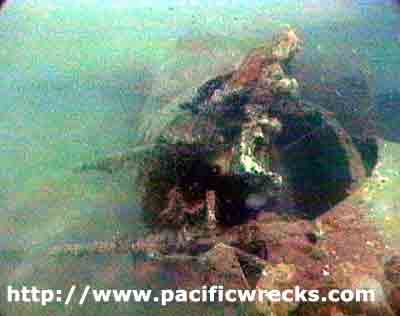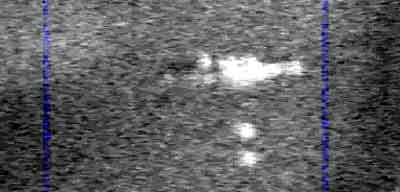
Rod Pearce aboard the bridge of his ship, the Barbarian

Top turret of B-25 "Stubborn Hellion"
at Kavieng

Sonar reading of B-25 "Stubborn Hellion" The two dots
are the seporated engines
Talk about your expeditions with Rod Pearce.
I first met Rod Pearce in Lae in 1992 aboard Bob Halstead's Telita at the end of an expedition to locate two wrecks the s'Jacob and S.S. Masaya. Bob had invited me to take part in this Canadian run expedition to relocate the s'Jacob a Dutch steamer originally found by Rod a few years earlier. The team was successful in locating the s'Jacob but not the wreck of the US Army's S.S. Masaya. The Masaya would take four years of research and a couple of expeditions aboard Kevin Baldwin's MV Tiata to locate. I lead the successful expedition to locate the Masaya in April of 1996.What type of reporting happens afterwards?
Video taken of a wreck is annotated and sent to those who helped in the research especially any of the men involved in the action. A video of the B-25 Stubborn Hellion shot down February 15, 1944 during a big raid on Kavieng now resting in 40 feet of water was given to the pilot Mike Hochella. This was the first time he has seen his plane since it went down. The tape also contained footage of several Japanese planes in Kavieng Harbor that were destroyed during the raid.I schedule a few days on either end of an expedition to New Guinea to conduct research at various Archives in Australia. If this is not possible a special trip is made as was done late in 1999. I traveled to Canberra and studied for two weeks at the Australian War Memorial and Australian National Archives researching a couple of wrecks with excellent success. The stops in Australia also give me time to acclimate to civilization before getting back to the trials and tribulations of daily live back home.
One of the things I do for each topic researched is to write a detailed report documenting the results of the research covering all information uncovered to that date. These reports are very detailed. They include descriptions of the military action going on at the time of the sinking, layout drawings of the wreck, its complete history, reason for its loss, interviews of eyewitnesses, maps, photographs, and declassified spy satellite photos of the area when available. This level of research requires that one be an accredited researcher to gain access and that the repositories for information actually be visited and time spent digging through thousands of records looking for that one scrap of information that will lead to a wreck. This requires a level of dedication to the task that is rare.
These reports, which each take several hundred hours to research and compile are given to Rod at the beginning of an expedition and used in locating the wreck. Once the wreck is located the report is updated with details of the hunt, photos and what will be seen on the wreck.
These reports are made available to Rod's guests for review prior to diving the wreck to give them the history of the wreck, the people associated with it and what they will see. A video is also made from footage shot while diving on the wreck. The video includes historical background; computer generated maps of the area and animations of the final mission of the aircraft or ship. Meanwhile research continues on the current list of wrecks and new wrecks as Rod adds them to the target list.
Previous | Next | Don Fetterly Main Page
